Top Competition Cartridges for 2022
The top competition cartridges for 2022 are a combination of newer rounds and classics that are capable of long-range accuracy and minimal recoil.
Competition shooters vary in form and function from their ridge-stomping hunting cousins, despite the fact that both tote a rifle. Undoubtedly, both parties use cartridges that overlap at times. However, competition shooters are usually closer to the cutting edge of bullet and ammunition technology.
Additionally, a bullet feels and performs differently exiting a 15-pound competition chassis versus a molded six-pound hunting rifle. Where hunters might fall into the realm of, “we’ve done it this way for years,” entrants into the top shooting matches tend to gravitate towards what works best. In our opinion, the top competition cartridges for 2022 are a combination of newer rounds and classics that are capable of long-range accuracy and minimal recoil.
See below for some classics and newcomers that round out the tour.
.223/5.56
Widely used in the military and law enforcement spectrum, anyone who donned their first firearm fighting for the Stars and Stripes has gained a comfort level with the .223/5.56. 3-Gun participants might especially benefit from this round. Its low recoil and serviceable accuracy pair nicely with semi-automatic rifles. As one of the most popular chamberings in the world, ammunition is usually readily available and configured in a number of bullet designs. And, if you’re wondering what the difference is between 5.56 versus .223, we’ll answer it for you here.
6.5 Creedmoor
Introduced in 2007 by Hornady, the 6.5 Creedmoor started a new craze in long-range shooting. Rather than filling longer brass with more powder, the primary focus in the development of the 6.5 Creedmoor was the bullet itself. Hornady introduced a line of bullets with a higher ballistic coefficient (more aerodynamic) that was less susceptible to atmospheric drag and wind drift and thus carried more energy downrange with less powder.
The 6.5 Creedmoor wasn’t only the first of the modern, mass-produced high-B.C. bullets. It was the first edition of a new trend of shooters who study long range efficiency rather than bullet drop. Nowadays, almost every rifle and bullet manufacturer has added the 6.5 Creed to their lineup.
6mm Creedmoor
A year after the introduction of the 6.5 Creedmoor, John Snow wrote a story for Outdoor Life detailing a new wildcat cartridge he had designed for the magazine article. Using the 6.5 Creedmoor as a parent case, he necked down the brass to hold a 6mm bullet. The 6mm Creedmoor provided all of the benefits of the 6.5 version but also added reduced recoil. The new round exploded onto the Precision Rifle Series scene and is now one of, if not the most popular round used in their events.
6.5 PRC
The new kid on the block, the 6.5 PRC (Precision Rifle Cartridge) is quickly gaining ground. Think about it as a souped-up turbo version of the 6.5 Creedmoor. Another round with superior aerodynamics, the 6.5 PRC gives shooters the heavier bullet of a 6.5 Creedmoor with the higher velocity of its 6mm equivalent.
Some shooters prefer the heavier bullets, sacrificing more recoil for a stouter round that isn’t pushed around as easily by the wind. Buyers beware, however. The hotter round also comes with reduced barrel life. Factory ammo has become more widely available but not as much as other longer-standing rounds.
According to Hornady, the 6.5 PRC utilizes moderate powder charges that result in repeatable accuracy, low recoil and reasonable barrel life, producing high velocities for target shooting beyond 1000 yards.
.308 Win.
If the 6.5 PRC is the new kid on the block, the .308 Win. is “old reliable.” While nothing about the .308’s performance is overly impressive, it has been used longer than any other round on this list and delivers heavy .30 caliber rounds from a compact short action platform. Furthermore, the military version of the .308 (7.62mm) is still the most widely used sniper cartridge by militaries and law enforcement. The ammo is generally easy to find, and virtually every manufacturer produces it. An argument could certainly be made that every gun safe should include a bolt-action .308.
.300 Win. Mag.
Think of the .300 Win. as the .308’s big brother. While both cartridges shoot identical projectiles (.30 caliber), the .300 sends rounds down range with significantly more speed and energy. Long-range marksmen like the fact that the .300 Win. Mag. carries velocities similar to smaller, faster rounds, but with heavier bullets that are less susceptible to wind drift. Like its little brother, nearly every manufacturer stocks shelves with a variety of options for this beast. The downside is that without a muzzle brake, recoil can be tough for some shooters.
.300 PRC
The .300 PRC takes the superb ballistic coefficient of Hornady’s PRC line and loads it in a heavy, fast magnum platform like its competitor, the .300 Win. Mag. Its long-range performance is outstanding, perhaps topping all .30 caliber cartridges. That being said, finding ammunition is challenging.
The .300 PRC steps up recoil even from the .300 Win. Mag. So for anyone other than the most recoil-tolerant shooters, a muzzle brake is a necessity to keep from developing a flinch. While it’s not yet wildly popular among competition shooters, long-range competitors consider the .300 PRC a strong up-and-comer.
.338 Lapua
The .338 Lapua is one of the biggest and baddest shoulder-fired rounds anywhere and would fall into the category of “ultra long-range.” The US military considers it effective out to 1,700 yards. Heavier bullets with more speed are needed in order to send a bullet that far and still carry energy downrange. While ammo is not as hard to find as you might think, expect to pay around $3 each time you pull the trigger.
No matter the goal, this list gives shooters the flexibility to find the right tool for the job. Both professionals and weekend warriors can choose from this list to adequately conquer their respective battlefields.












